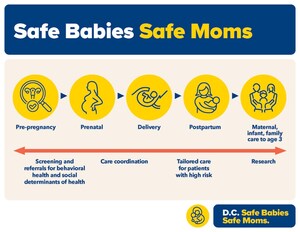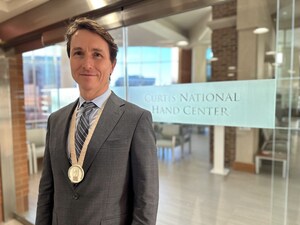MedStar Health Celebrates 40th Anniversary of MedSTAR Transport Air Medical Service
Since 1983, the trailblazing hospital-based transport service has treated and transported nearly 100,000 patients via air and ground ambulance across the Mid-Atlantic region
COLUMBIA, Md., June 28, 2023 /PRNewswire/ -- MedStar Health is honoring the groundbreaking and enduring legacy of MedSTAR Transport, which first launched its life-saving air medevac services 40 years ago.
On July 3, 1983, MedSTAR Transport pioneered hospital-based air medical services in the Washington, D.C., area by flying its first critical care patient from Prince William County, Virginia, to the hospital now known as MedStar Washington Hospital Center. Since then, the program has grown to four air ambulance helicopters, a fleet of ten ground ambulances, a dedicated communications center, and a team of approximately 120 medical providers, flight crew members, communications specialists, and others who have served patients across the Mid-Atlantic region and beyond for 40 years.
"It's pretty remarkable growth and a pretty remarkable achievement," said M. Joy Drass, MD, MedStar Health executive vice president and chief operating officer, who also served as the program's first medical director and flew with the crew on the very first MedSTAR Transport flight. According to Dr. Drass, the first patient suffered a spinal cord injury and required acute intervention at MedStar Washington Hospital Center and later, rehabilitation services at what is now MedStar National Rehabilitation Hospital.
"It's actually a good example of how MedSTAR Transport is more than just ambulances and helicopters," Dr. Drass said. "It's a system of care that moves patients into hopefully everything that they're going to need for their journey."
"As the medical director for our air and ground teams, I'm thrilled to be a part of this critical service that continues to grow with the full support of MedStar Health to help patients receive the care they need when they need it," said MedSTAR Transport Medical Director J. Matthew Sasser, MD. "Long before I started working for MedStar Health, I called on MedSTAR Transport often to transport critical patients who needed a higher level of care than was offered at my hospitals. Their teams epitomized professionalism then and we still do today."
A Cornerstone of Care
Today, the service cares for about 6,000 patients a year, most of whom start in community hospitals in the region and need a higher level of care. In addition to MedStar Washington Hospital Center and area community hospitals, MedStar Health hospitals with helipads where MedSTAR Transport can land and take off with patients include:
- MedStar Georgetown University Hospital
- MedStar Franklin Square Medical Center
- MedStar Montgomery Medical Center
- MedStar Southern Maryland Hospital Center
- MedStar St. Mary's Hospital
- MedStar Union Memorial Hospital
Transferring patients proved critically important at the height of the COVID-19 pandemic, as MedStar Health relied on MedSTAR Transport — which saw a 40% increase in transport volume — to distribute severely ill patients across the health system. With the service's sophisticated communications and transfer center and a newly-appointed triage officer, the system prevented any one of its individual hospitals from becoming overloaded and ensured that patients with all medical conditions could receive the support they needed. As a result, MedStar Health cared for one in four of the region's COVID-19 patients.
"The pandemic was like nothing we've ever seen, but it stretched us to be better," Dr. Drass said. "Today, health care is provided in many different locations. MedSTAR Transport is a safety net that allows us to move patients, if necessary, even when they need a higher level of care. It's a major piece of our distributed care delivery network and one of the foundations of our MedStar Health system."
A Beacon of Hope
Initially, MedSTAR Transport emphasized its response to the scenes of serious accidents and injuries to treat and transport trauma patients in the Washington, D.C., area. Four decades later, the program still transfers patients to nearby Level I Trauma Centers from emergency situations. The most famous example of this came during the 9/11 attacks, when a MedSTAR Transport air ambulance was one of the first medevac helicopters to land at the Pentagon to rescue injured workers. MedSTAR Transport was also the only civilian medevac program authorized to continue its critical mission in this region during the national air space closure.
Over the years, thousands of patients like Kevin Brooks, 69, of Annapolis, express gratitude for the now-iconic blue-and-yellow air and ground transport vehicles, as well as the brave healthcare heroes who use them to provide life-saving care. In 2021, when the local musician suffered a heart attack on a boat during a Chesapeake Bay July Fourth celebration, MedSTAR Transport airlifted him to MedStar Washington Hospital Center where he received critical cardiac care.
"When you see that yellow-and-blue, helicopter, you know someone's lucky up there," Brooks said. "I want to say thank you to the crew — Ron, Mike, and Scott — for helping get us through those tough times. MedSTAR Transport is the reason I was able to get the services I needed at the time I needed them. From the bottom of my healing heart, thank you."
Devon Hall, 29, was transported to MedStar Health's Curtis National Hand Center, the state's only designated hand trauma center after a machine accident at work 'degloved' his hand and amputated three fingers. There, he could get from the 9th floor helipad atop MedStar Union Memorial Hospital, to the operating room within critical minutes.
"They were totally focused on taking care of me and getting me there as fast as possible," said Hall. "I can't imagine how long it would have taken to get to the Curtis National Hand Center by car, or what my recovery would have been like then. I really want to thank the crew."
An Industry Innovator
The standard configuration of a MedSTAR Transport flight crew includes a pilot, a critical-care nurse, and a critical-care paramedic, who are trained to provide a full range of critical care and general patient services. Additional crew — including a physician and a respiratory therapist — can be added as needed.
As healthcare technology has evolved since 1983, MedSTAR Transport crews now require higher levels of training to provide much more advanced levels of care in the air and on the road. For example, MedSTAR Transport now routinely manages patients requiring advanced respiratory therapies, such as high flow nasal oxygen and APRV, Intra-Aortic Balloon Pumps, Ventricular Assist Devices, Impellas, ECMO, and more. Adapting these traditionally hospital-based therapies for transport translated to better care for patients suffering from severe respiratory symptoms during the COVID-19 pandemic.
"I came to MedSTAR Transport because it's such a unique environment that really allows the opportunity to grow in many different directions," said Kayla Lynch, RN, BSN, director of Nursing Professional Development for MedSTAR Transport. "Educationally and professionally, you're working alongside clinicians who challenge you to be better and provide better care, which serves our communities in a really big way. MedSTAR Transport has a very strong legacy, and that's going to be really important as we start looking at how to build a bigger and better MedSTAR Transport in the future."
Moving forward, MedSTAR Transport plans to continue realizing the full and evolving potential of medical transport by continuing to expand its ground medevac program, maintaining its historic air service, ensuring new career growth opportunities for its crews, and providing regional communities with even higher levels of service.
Regardless of whether its crews will be saving lives in the air, the ground, or elsewhere, MedSTAR Transport knows that continued success over the next 40 years will begin with dedicated professionals willing to do what is necessary to push the limits of mobile health care — the same spirit that changed the healthcare industry in 1983.
"They were very exciting times," said Wade Smith, the 40-year veteran flight paramedic who served on MedSTAR Transport's first flight. "They're still exciting times. That's why I'm still doing it."
Visit this link to download a MedSTAR Transport video package featuring aerial and ground b-roll footage and interviews.
Visit this link to download historical photos for use in publications.
For more information about MedSTAR Transport, visit: www.medstarhealth.org/Transport
SOURCE MedStar Health

WANT YOUR COMPANY'S NEWS FEATURED ON PRNEWSWIRE.COM?
Newsrooms &
Influencers
Digital Media
Outlets
Journalists
Opted In





Share this article